If your vehicle needs to be towed
If towing is necessary, we recommend having your vehicle towed by your Lexus dealer or a commercial towing service, using a lift-type truck or a flatbed truck.
Use a safety chain system for all towing, and abide by all state/provincial and local laws.
Before towing
The following may indicate a problem with your hybrid transmission.
Contact your Lexus dealer before towing.
The hybrid system is operating but the vehicle will not move.
The vehicle makes an abnormal sound.
Emergency towing
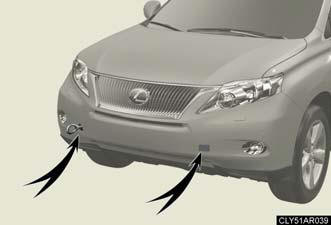
If a tow truck is not available in an emergency, your vehicle may be temporarily towed using a cable or chain secured to the emergency towing eyelet(s). This should only be attempted on hard surfaced roads for short distances at under 18 mph (30 km/h).
A driver must be in the vehicle to steer and operate the brakes. The vehicle’s wheels, drive train, axles, steering and brakes must be in good condition.
Installing towing eyelets
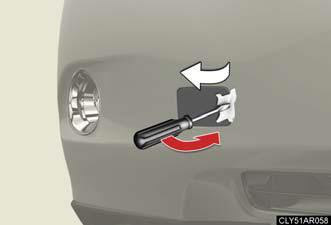
Remove the eyelet cover using a flathead screwdriver.
To protect the bodywork, place a rag between the screwdriver and the vehicle body, as shown in the illustration.
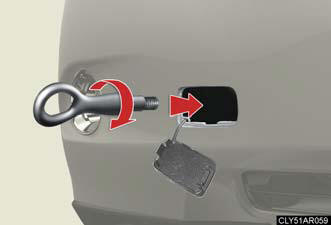
Insert the towing eyelet into the hole and tighten partially by hand.
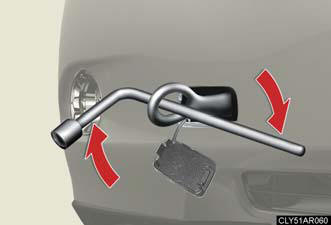
Tighten down the towing eyelet securely using a wheel nut wrench.
Towing with a sling-type truck
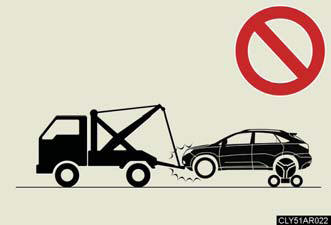
Do not tow with a sling-type truck to prevent body damage.
Towing with a wheel-lift type truck
- From the front (2WD models).
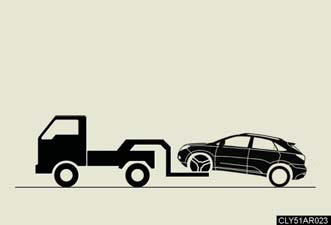
Release the parking brake.
- From the front (AWD models).
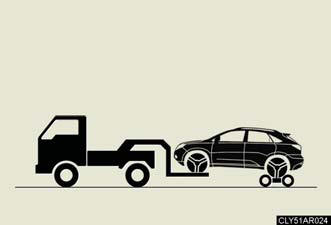
Use a towing dolly under the rear wheels.
- From the rear.
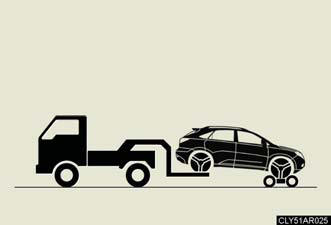
Use a towing dolly under the front wheels.
Using a flatbed truck
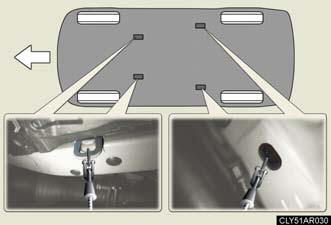
If your Lexus is transported by a flatbed truck, it should be tied down at the locations shown in the illustration.
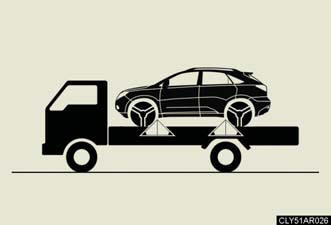
If you use chains or cables to tie down your vehicle, the angles shaded in black must be 45°.
Do not overly tighten the tie downs or the vehicle may be damaged.
Before emergency towing
1. Release the parking brake.
2. Shift the shift lever to N.
3. Turn the “POWER” switch to ACCESSORY (hybrid system off) or ON (hybrid system operating) mode.
CAUTION:
Caution while towing
Use extreme caution when towing the vehicle.
Avoid sudden starts or erratic driving maneuvers which place excessive stress on the emergency towing eyelets and the cables or chains.
If the hybrid system is off, the power assist for the brakes and steering will
not
function, making steering and braking more difficult.
Installing towing eyelets to the vehicle Make sure that towing eyelets are installed securely.
If not securely installed, towing eyelets may come loose during towing. This may lead to accidents that cause serious injury or even death.
NOTICE:
To prevent causing serious damage to the hybrid transmission when towing using
a wheel-lift type truck
2WD models: Never tow this vehicle from the rear with the front wheels on the
ground.
AWD models: Never tow this vehicle with any of the wheels in contact with the ground.
To prevent damaging the vehicle when towing using a wheel-lift type truck
When raising the vehicle, ensure adequate ground clearance for towing at the
opposite end of the raised vehicle. Without adequate clearance, the vehicle
could
be damaged while being towed.
To prevent body damage when towing using a sling-type truck Do not tow with a sling-type truck, either from the front or rear.
See also:
What’s it up against?
Equipped with a V8 engine, the GS’ biggest traditional rivals come from
Germany – namely the BMW 550i and Mercedes-Benz E550. But can-do home-market
competitor Infiniti’s new M56 presents serious ...
Emission inspection and maintenance (I/M) programs
Some states have vehicle emission inspection programs which include
OBD (On Board Diagnostics) checks. The OBD system monitors the operation
of the emission control system.
If the malfunction indic ...
Lexus GS 300 Review
A refined and elegant car since its early-1990s inception, the midsize Lexus
GS 300 sedan always came up short in the personality department. Partly, this
was a problem of perception. Lexus initia ...
